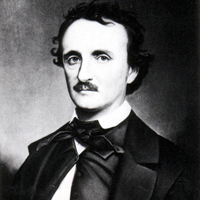Edgar Allan Poe - Biography and Works
Edgar Allan Poe is an American writer, known as a poet and a critic both famous for his short stories, especially the tales of the mysterious and macabre. The literary merits of Poe’s writings have been debated since his death, but his works have remained popular and many major American and European writers have professed their artistic debt to him.

Edgar Allan Poe (1809-1849)
Poe was born in Boston, Massachusetts and later he was orphaned in his early childhood. Later he was raised by John Allan as a godfather. Allan was a successful businessman of Richmond, Virginia and later Poe was taken to England at the age of six. Poe was sent to the private school. When he returned to the United States in 1820, he continued his study in private schools again and later he attended the University of Virginia. Poe published Tamerlane and Other Poems (1827) anonymously.
In 1829 his second volume of verse, Al Aaraaf, was published. Poe's third book, Poems, appeared in 1831.The short stories and poetry of Poe reflects the writer’s haunting imagination. “The Raven” (1845), one of Poe’s most famous poems, tells the tale of a poet lost in memories of his dead love, Lenore. A raven startles the poet and repeatedly answers his tormented questions about Lenore with the word, “Nevermore.” The very opening lines of “The Raven” set an unforgettably striking gloomy tone for the poem characteristic of Poe’s style.
In “The Raven” the narrator is overwhelmed by melancholy and omens of death. He is overcome by the raven as a symbol of death, to the point where his own sanity is in question. Poe’s extraordinary manipulation of rhythms and sound is particularly evident in it, in “The Bells”, a poem that seems to echo with the chiming of metallic instruments and “The Sleeper” which reproduces the state of drowsiness. “Lenore” (1831) and “Annabel Lee” (1849) are verse lamentations on the death of a beautiful young woman, most probably his own wife. Among Poe’s poetic output, about a dozen poems are remarkable for their flawless literary construction and for their haunting themes and meters. His poems characteristically capture the imagination with their dark imagery and fascination with the macabre. Although Poe is widely credited as the originator of the modern detective story and as a pioneer in the field of mystery writing, he thought of himself first as a lyric poet, and published poems and treatises on poetry.
Poe has devoted great effort to writing poetry that was unlike anything before it. A careful craftsman, he examined in detail the effects that his every poetic choice had. Poet’s poetry earned little respect from his contemporaries, who dismissed him as “the jingle man.” He had, said Whitman, “the rhyming art to excess.” Yet Poe’s nightmarish scenes, unnerving plots, and probing of abnormal psychology gave his poetry, as well as his tales, a haunting, memorable quality that makes him one of the most admired innovators in American literature. The opening lines of his best known poem, “The Raven” (1845), demonstrate the Poet’s love of rhyming and his use of varying rhythm: “Once upon a midnight dreary, while I pondered, weak and weary, / Over many a quaint and curious volume of forgotten lore.” But the haunting rhymes and rhythm are immensely powerful functional tools to aid an even more immensely powerful poetry of the psyche.
Poe is one of the proponents of American Romanticism. Poe’s romanticism verges on the psychological. Like romantic theorists in Europe, Poe was opposed to overt didacticism; he developed an argument on philosophical and psychological grounds that teaching was no part of the legitimate poetic purpose. He believed that the instructional purpose was antithetical to the mood in which poetry was written. Poetry originated in a state of feeling and attempted to transmit that feeling. Poet’s absorption in the works of the romantic period, like those of Coleridge, Shelley, Keats, reinforced his faith in the powers of the imagination to transcend the limits of ordinary experience and to explore the depths of the human soul. “Truth”, however, was arrived at in an unimpassioned, ratiocinative manner. Continuing his psychological analysis, Poe argued that the very composition of the human mind proved that the poets should not attempt to convey the “truth”. The chief faculties of the human mind, he said, were the intellect, the taste, and the moral sense. It was the business of the intellect to arrive at the truth. The function of the moral sense was to inform the individual of right and wrong. It was the sole function of the taste to inform the individual of beauty, and poetry (all the fine arts, in Poe’s sense) served the taste. Thus the primary function of art is to evoke an aesthetic response. However, Poe had not adopted something like Keats’s claim that beauty was truth and truth was beauty. Instead, Poe’s notion of truth encompassed whatever could be verified by the reason demonstrated by science, or recognized by the senses.
Cite this Page!
Sharma, K.N. "Edgar Allan Poe - Biography and Works." BachelorandMaster, 4 Nov. 2013, bachelorandmaster.com/biography/edgar-allan-poe.html.
Related Topics
The Raven: Summary and Analysis
The City in the Sea: Summary and Analysis
 |
bachelorandmaster.com |